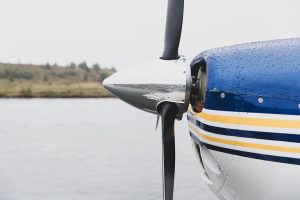Don’t be fooled by the fact that seaplanes are relatively uncommon in the aviation sector. A seaplane tour of Quebec’s most remote regions during the summer and fall is an unforgettable experience. In this article, we discuss the safety of seaplanes as well as different characteristics of these aircraft.
What is a seaplane?
A seaplane is a powered fixed-wing aircraft with the ability to take off and land on water. Float planes and seaplanes are the two types of planes that are normally categorized based on technical qualities. Seaplanes are often significantly larger and can accommodate more people.
What’s the difference between a floatplane and a seaplane?
A floatplane (or pontoon plane) has floats or pontoons that serve as a landing and takeoff surface instead of a fuselage/belly that can land directly on water. A float plane’s fuselage does not come into direct contact with water. Instead, a floatplane takes off and lands on floats or pontoons that make contact with the water. The fuselage or belly of a seaplane, on the other hand, lands directly on the water.
What is the most common reason for a plane to crash?
Pilot mistake, air traffic controller error, design and manufacturer defects, maintenance failures, sabotage, or adverse weather are all possible causes of seaplane accidents.
Here are some of the most commonly reported causes of aviation accidents:
Human Factors
Pilot mistake was shown to be involved in 53 % of worldwide fatal commercial aircraft crashes between 1950 and 2010, according to Plane Crash Info. Pilots who misread flight equipment, underestimate weather conditions, or fail to appropriately address mechanical faults are responsible for many aviation mishaps. Pilot mistake is widely regarded as the leading cause of aviation crashes.
Airline Corporate Negligence
The corporate airline sector prioritizes punctuality, turnover, and cost-cutting over public safety. Corporate rules are pressuring pilots and crew to make risky landings to minimize paperwork, fly with the bare minimum of fuel, and make other risky decisions. Airline corporate negligence has become a major cause in airline crashes in recent years.
Maintenance Negligence
Cutting shortcuts and outsourcing aircraft maintenance and inspections is a popular trend in the aviation industry. It has become increasingly frequent for plane crashes to be linked to airlines doing everything possible to keep planes in the air. The National Transportation Safety Board (NTSB) called the Alaska Airlines Flight 261 disaster off the coast of California a maintenance accident. The plane’s 88 passengers and crew members were all killed in the catastrophe.
Weather
People frequently assume that weather is a major factor in aviation crashes. While weather is thought to be responsible for about 12% of all aviation crashes, it is rarely the only reason. When dangerous weather conditions arise, most flights are grounded, and failure to do so could be viewed as negligence.
Are seaplanes safe?
You may have questions like:
- How high do seaplanes fly?
- How fast do seaplanes fly?
- Are seaplanes safe?
- Are seaplanes stable?
Like any transport mode, there are risks involved. We will answer and solve your queries in the following paragraph.
Why do people believe seaplanes are unsafe?
It all comes down to one major thing – the wilderness. Unlike jets and airplanes, seaplanes are at the mercy of the environment. Conditions on the water can change quickly and are not regulated in the same way that runways are — birds, floating logs, and waves could appear at any time.
Pilots in more distant places, like Alaska or north-western Canada, must rely on other pilots to communicate their position, and intended flight path over the radio. There is no air traffic control, unlike at major airports, to coordinate take-off and landing schedules.
If an incident occurs, seaplanes have to be light enough to land on water. There is no doubt that seaplanes have an added risk, but with each risk there is a mass of training, skills, and experience seaplane pilots must gain to minimize said risk.
Why seaplanes are safe!
Seaplanes take off and land all over the world on a daily basis. The vast majority of these occasions go off without a hitch. Seaplanes, like all planes, are susceptible to mechanical problems and human error. Seaplanes, unlike other planes, are subjected to stricter regulations, and seaplane pilots possess more sophisticated flying skills than most land pilots.
Seaplane trips should be booked through trusted firms, as they ensure high levels of maintenance and safety. The maintenance of the Beaver DHC-2 and Turbo Otter DHC-3T aircraft is a critical aspect of Air Tunilik’s seaplane operations, with safety being our first priority. To assure your safety onboard our seaplanes, our experienced pilots participate in rigorous annual training programs. Put simply, seaplanes are safe when they are maintained and piloted by trusted, experienced pilots with seaplane rating from reliable companies.
How fast do seaplanes go?
Air Tunilik has three types of seaplanes in its fleet, each of which has a different speed.
DHC-2 Turbo Beavers
The DHC-2 Turbo Beavers can operate as a landplane from unsurfaced field strips or forest clearings up to 300 meters (1,000 feet) in length. When flying a seaplane such as this one under Visual Flight Rules, it can carry a load of around half a tonne (1,000 lbs) on realistic stages for about 1,000 kilometers (VFR).
Specifications include:
- Capacity up to 6 passengers
- Wingspan: 57.2 feet
- Height: 10.4 feet
- Length: 32.8 feet
- Cruising speed: 180 km/h
DHC-3T Turbo Otter
Turbo Otters are commonly utilized for charters, tourist work, freight, and scheduled service, as well as transporting passengers and large loads deep into the jungle to airfields where it would be impossible for most other planes to land.
Specifications include:
- Capacity up to 9 passengers
- Wingspan: 57.2 feet
- Height: 12.3 feet
- Length: 45.2 feet
- Cruising speed: 210 km/h
DHC-3T Otter
The floats, also known as pontoons, on this seaplane allow for easy landing and take-off on bodies of water throughout Canada, including oceans, seas, rivers, and lakes, giving access to destinations that would otherwise be inaccessible.
Specifications include:
- Capacity up to 9 passengers
- Wingspan: 57.2 feet
- Height: 12.3 feet
- Length: 41.8 feet
- Cruising speed: 180 km/h
Can seaplanes land anywhere?
Yes… and No. A seaplane has wheels as well as floats meaning it can land on any terrain that is flat enough. According to the Federal Aviation Administration, a seaplane can land on any public body of water, provided the pilot does not endanger people or property. However, landing on private bodies of water can be done only with permission from the owners.
Wanting to take to the skies to see beautiful scenery?
Air Tunilik, which was founded in 2002, is proud to be Quebec’s largest bush aviation company for seaplane tours. Because of our seaplane fleet, extensive hydrobase network, and extensive experience in the area, we are an informed choice for your air transportation needs. We specialize in seaplane and ski plane charter for specialized transportation around Quebec.
Our seaplanes can take you over some of Quebec’s most beautiful ecosystems and mountains. All our seaplane bases in the province, including Natashquan, Havre St-Pierre, Manic 5, Caniapiscau, and Sept-Îles, provide scenic flights. Our pilots will captivate and encourage you to see Quebec and its wonders in a different light.
During the summer and fall, take a seaplane tour of Quebec’s most remote regions. Summer’s spectacle and pleasant weather, as well as the colors of winter, can all be enjoyed from above. If you’re interested in taking a seaplane tour of Quebec’s breathtaking scenery, feel free to contact us.






